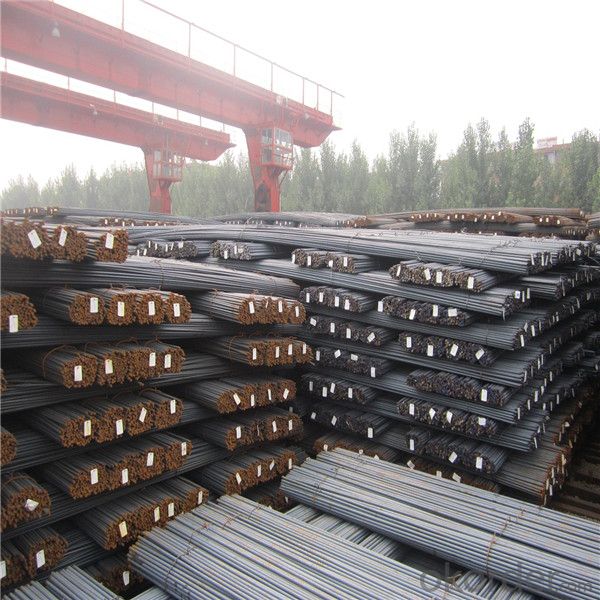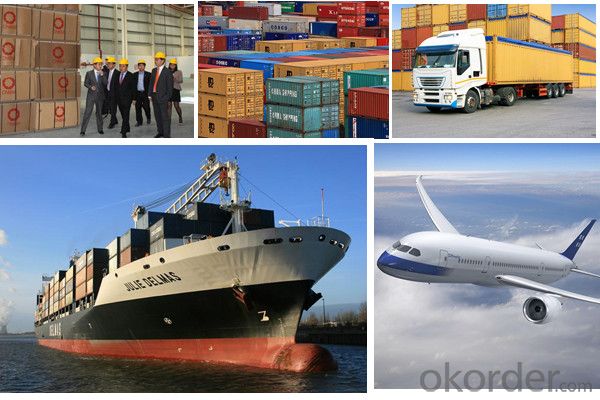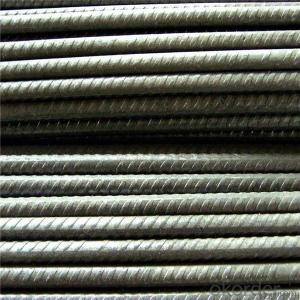Metallic material steel rebar for construction concrete for building metal
- Loading Port:
- China main port
- Payment Terms:
- TT OR LC
- Min Order Qty:
- 1000 m.t.
- Supply Capability:
- 17497 m.t./month
OKorder Service Pledge
OKorder Financial Service
You Might Also Like
Item specifice
Epoxy-coated rebar or stainless steel rebar may be employed in these situations at greater initial expense, but
significantly lower expense over the service life of the project. Fiber-reinforced polymer rebar is now also being
used in high-corrosion environments
Most grades of steel used in rebar cannot accept welding; such as, to adjacent steel plates or as means to bind
single pieces of rebar together. However, special grades of rebar steel and welding rods make welding by expert
welders possible.
To prevent workers from accidentally impaling themselves, the protruding ends of steel rebar are often bent over
or covered with special plastic "mushroom" caps.
Product Description :
Chemical composition (%): | Steel | C | Si | Mn | P | S | Ceq | ||||
HRB335 |
0.25 |
0.80 |
1.60 |
0.045 |
0.045 | 0.52 | |||||
HRB400 | 0.54 | ||||||||||
HRB500 | 0.55 | ||||||||||
Mechanical properties | Steel | Rel/ MPa | Rm/ MPa | A/ % | Agt/ % | ||||||
≥ | |||||||||||
HRB335 | 335 | 455 | 17 |
7.5 | |||||||
HRB400 | 400 | 540 | 16 | ||||||||
HRB500 | 500 | 630 | 15 | ||||||||
Package: | Standard export packing or as customer's request | ||||||||||
Application: | Construction, building, bridge, road. ect | ||||||||||
Payment terms | 1).100% irrevocable L/C at sight. | ||||||||||
Delivery time | 15-30 days after receipt of L/C or deposit by T/T | ||||||||||
|
Features
1、Pure steel quality, stable chemical contents, small tolerance.
2、Constant Quality, good drawing performance.
3、High dimension accuracy degree, accuracy degree of Level C up to 80%, smooth surface, less scale, easy to be pickled.
4、Automatic bundling with 4 lines by Machine in tidy and good looks
5、Big high quality percentage, small coil percentage, and heavy coil weight for Hard Coil.
6、High sorbitizing percentage.
Packing:
In bundles, each bundle weight 3.5 tons. Load by container or by bulk verssel.


FAQ:
1.Q: What's your MOQ(minimum order quantity)?
A: One full container, mixed acceptable .
2. Q: What's your packing methods?
A: Packed in bundle or bulk ..
3. Q: How can I buy CNBM products in my country?
A:Please send us an inquiry or email ,we will reply to you if there is distributor in your country
4. Q: Can we visit your factory?
A: Warmly welcome. Once we have your schedule, we will arrange the professional sales team to follow up your case.
5. Q: How long does it take to get the product if i place an order?
A:With the process of your requirements,we will pack and deliver in 3-7 days. If it is by sea shipment,it will take 15-45 days depending on different locations
- Q:What is the effect of steel rebars on the seismic performance of a structure?
- Steel rebars have a significant positive effect on the seismic performance of a structure. By reinforcing the concrete, rebars enhance the strength and ductility of the building, allowing it to better withstand seismic forces. This reinforcement helps prevent structural failure, reduces the risk of collapse, and improves overall stability during an earthquake.
- Q:What is the effect of vibration on steel rebars?
- The effect of vibration on steel rebars is generally positive as it helps to compact the concrete around the rebars, enhancing their bonding and improving the overall strength and durability of the reinforced concrete structure. Vibration also helps to remove air voids and excess water, resulting in a more dense and uniform concrete mixture.
- Q:What is the impact of steel rebars on the construction timeline?
- The construction timeline is greatly affected by steel rebars. These rebars are essential in reinforced concrete structures and provide strength and durability to the overall construction. It is crucial to properly install and integrate them into the concrete elements to ensure the building's structural integrity. To begin with, delays in procuring or delivering steel rebars can have a significant impact on the construction timeline. This can cause a ripple effect, postponing or slowing down construction activities that require the presence of rebars, such as formwork, concrete pouring, and curing. As a result, the overall construction timeline may be delayed. Furthermore, the installation of rebars is a meticulous and time-consuming process. Construction teams must accurately place and secure the rebars according to design specifications and engineering drawings. This involves cutting, bending, and tying rebars to create the necessary reinforced structures. Any errors or rework needed during this phase can lead to additional time being spent, potentially causing delays in subsequent construction activities. In addition, coordination between different construction trades is crucial when working with rebars. The integration of electrical and plumbing systems with rebars must be done correctly before pouring the concrete. Miscommunication or lack of coordination can result in conflicts and rework, causing delays in the construction timeline. Moreover, the quality of rebars is vital to the construction timeline. Poor quality or defective rebars can pose safety concerns and potential structural issues. In such cases, remedial actions, such as removing and replacing faulty rebars, need to be taken, leading to delays and additional costs. In conclusion, steel rebars significantly impact the construction timeline. Factors such as availability, timely delivery, accurate installation, coordination with other trades, and quality influence the overall progress of a construction project. Proper planning, communication, and monitoring are essential to effectively incorporate rebars into the construction process, minimizing potential delays, and keeping the project on schedule.
- Q:How do steel rebars improve the durability of concrete structures?
- Concrete structures can be made more durable in various ways through the use of steel rebars. Firstly, steel rebars act as reinforcement, adding strength and stability to the structure. When combined with concrete, the high tensile strength of steel rebars helps resist cracking and prevent collapse under heavy loads or seismic activities. Secondly, steel rebars assist in controlling the formation and spread of cracks in concrete structures. Concrete is strong in compression but weak in tension, making it prone to cracking under tensile forces. By strategically placing steel rebars within the concrete, cracks are minimized and prevented from spreading, thereby improving the overall durability of the structure. Furthermore, steel rebars enhance the resistance of concrete structures against corrosion. The highly alkaline nature of concrete forms a protective layer around the steel rebars, preventing rust. This corrosion resistance ensures the rebars maintain their structural integrity over time, reducing the risk of deterioration and enhancing the longevity of the concrete structure. Moreover, steel rebars also increase the fire resistance of concrete structures. With their high melting point, steel rebars can withstand high temperatures, preventing the concrete from losing its structural integrity during a fire. This additional fire resistance ensures the stability and safety of the concrete structure in case of a fire, further enhancing its durability. In conclusion, the inclusion of steel rebars significantly enhances the durability of concrete structures by providing added strength, controlling cracks, improving corrosion resistance, and increasing fire resistance. These advantages contribute to the longevity and safety of concrete structures, making them more reliable and sustainable in the long term.
- Q:What is the tensile strength of a steel rebar?
- The tensile strength of a steel rebar typically ranges from 60,000 to 100,000 pounds per square inch (psi).
- Q:How do steel rebars contribute to the seismic performance of concrete buildings?
- Steel rebars contribute to the seismic performance of concrete buildings by providing reinforcement and strength to the structure. The rebars help to distribute and dissipate the energy generated during an earthquake, increasing the building's ability to withstand the seismic forces. They enhance the concrete's tensile strength, preventing cracking and enhancing its overall durability. The combination of concrete and steel rebars creates a composite material that can absorb and withstand the lateral forces caused by ground shaking, reducing the risk of structural failure during seismic events.
- Q:How do steel rebars help in distributing load in a structure?
- Steel rebars help in distributing load in a structure by providing reinforcement and strength to concrete. When embedded within the concrete, rebars increase its tensile strength, allowing it to better resist cracking and deformation under load. This distribution of load helps to prevent concentrated stress points and ensures a more even distribution of forces throughout the structure, increasing its overall stability and durability.
- Q:How do steel rebars affect the thermal properties of a structure?
- Steel rebars can increase the thermal conductivity of a structure, making it more prone to heat transfer.
- Q:Are there any safety precautions to be followed while working with steel rebars?
- Yes, there are several safety precautions to be followed while working with steel rebars. Some of these precautions include wearing appropriate personal protective equipment (PPE) such as gloves, safety glasses, and steel-toed boots to protect against cuts, punctures, and eye injuries. It is important to handle rebars with care and avoid dragging or dropping them to prevent injuries. Workers should also be trained in safe lifting techniques and use mechanical aids if necessary to avoid strain or back injuries. Additionally, it is essential to maintain a clean and organized work area to prevent tripping hazards.
- Q:How do steel rebars contribute to the energy efficiency of a building?
- Steel rebars contribute to the energy efficiency of a building in several ways. Firstly, steel rebars are used to reinforce concrete structures, such as beams, columns, and walls. This reinforcement helps to increase the structural integrity of the building, allowing it to withstand various loads and forces. This, in turn, reduces the need for excessive materials in the construction process, leading to a more energy-efficient building. Additionally, steel rebars have excellent thermal conductivity properties. This means that they can efficiently transfer and distribute heat throughout the building, helping to regulate the internal temperature. By evenly distributing heat, steel rebars help to minimize temperature fluctuations, reducing the need for excessive heating or cooling systems, thus saving energy. Moreover, steel rebars have a long lifespan and require minimal maintenance. This durability ensures that the building remains structurally sound over time, reducing the need for frequent repairs or replacements. As a result, the energy consumed in maintenance and renovation activities is significantly reduced. Furthermore, the use of steel rebars allows for the construction of larger, open spaces with fewer supporting columns. This design flexibility facilitates the integration of natural light and ventilation, reducing the reliance on artificial lighting and air conditioning systems. By maximizing natural resources, steel rebars contribute to the energy efficiency of the building. In conclusion, steel rebars play a vital role in enhancing the energy efficiency of a building. Their ability to reinforce structures, efficient thermal conductivity, durability, and design flexibility all contribute to reducing the energy consumption associated with construction, maintenance, and operation of the building.
1. Manufacturer Overview |
|
|---|---|
| Location | |
| Year Established | |
| Annual Output Value | |
| Main Markets | |
| Company Certifications | |
2. Manufacturer Certificates |
|
|---|---|
| a) Certification Name | |
| Range | |
| Reference | |
| Validity Period | |
3. Manufacturer Capability |
|
|---|---|
| a)Trade Capacity | |
| Nearest Port | |
| Export Percentage | |
| No.of Employees in Trade Department | |
| Language Spoken: | |
| b)Factory Information | |
| Factory Size: | |
| No. of Production Lines | |
| Contract Manufacturing | |
| Product Price Range | |
Send your message to us
Metallic material steel rebar for construction concrete for building metal
- Loading Port:
- China main port
- Payment Terms:
- TT OR LC
- Min Order Qty:
- 1000 m.t.
- Supply Capability:
- 17497 m.t./month
OKorder Service Pledge
OKorder Financial Service
Similar products
New products
Hot products
Related keywords





























